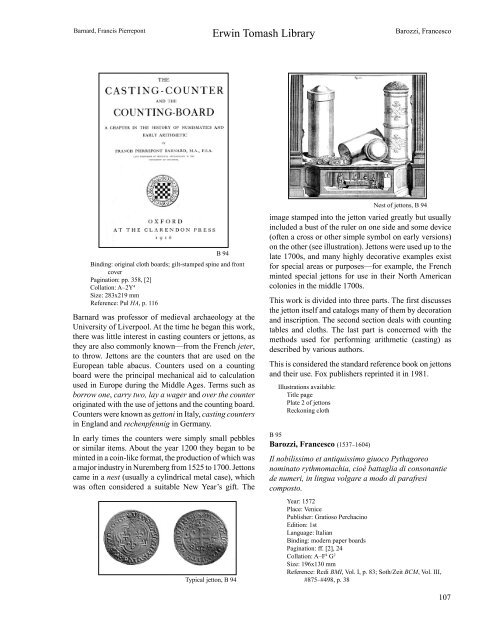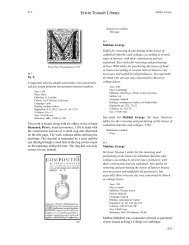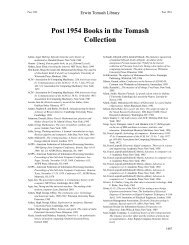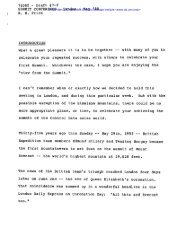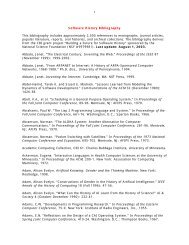B chapter.indd - Charles Babbage Institute - University of Minnesota
B chapter.indd - Charles Babbage Institute - University of Minnesota
B chapter.indd - Charles Babbage Institute - University of Minnesota
You also want an ePaper? Increase the reach of your titles
YUMPU automatically turns print PDFs into web optimized ePapers that Google loves.
Erwin Tomash Library<br />
Barnard, Francis Pierrepont Barozzi, Francesco<br />
B 94<br />
Binding: original cloth boards; gilt-stamped spine and front<br />
cover<br />
Pagination: pp. 358, [2]<br />
Collation: A–2Y 4<br />
Size: 283x219 mm<br />
Reference: Pul HA, p. 116<br />
Barnard was pr<strong>of</strong>essor <strong>of</strong> medieval archaeology at the<br />
<strong>University</strong> <strong>of</strong> Liverpool. At the time he began this work,<br />
there was little interest in casting counters or jettons, as<br />
they are also commonly known—from the French jeter,<br />
to throw. Jettons are the counters that are used on the<br />
European table abacus. Counters used on a counting<br />
board were the principal mechanical aid to calculation<br />
used in Europe during the Middle Ages. Terms such as<br />
borrow one, carry two, lay a wager and over the counter<br />
originated with the use <strong>of</strong> jettons and the counting board.<br />
Counters were known as gettoni in Italy, casting counters<br />
in England and rechenpfennig in Germany.<br />
In early times the counters were simply small pebbles<br />
or similar items. About the year 1200 they began to be<br />
minted in a coin-like format, the production <strong>of</strong> which was<br />
a major industry in Nuremberg from 1525 to 1700. Jettons<br />
came in a nest (usually a cylindrical metal case), which<br />
was <strong>of</strong>ten considered a suitable New Year’s gift. The<br />
Typical jetton, B 94<br />
image stamped into the jetton varied greatly but usually<br />
included a bust <strong>of</strong> the ruler on one side and some device<br />
(<strong>of</strong>ten a cross or other simple symbol on early versions)<br />
on the other (see illustration). Jettons were used up to the<br />
late 1700s, and many highly decorative examples exist<br />
for special areas or purposes—for example, the French<br />
minted special jettons for use in their North American<br />
colonies in the middle 1700s.<br />
This work is divided into three parts. The first discusses<br />
the jetton itself and catalogs many <strong>of</strong> them by decoration<br />
and inscription. The second section deals with counting<br />
tables and cloths. The last part is concerned with the<br />
methods used for performing arithmetic (casting) as<br />
described by various authors.<br />
This is considered the standard reference book on jettons<br />
and their use. Fox publishers reprinted it in 1981.<br />
Illustrations available:<br />
Title page<br />
Plate 2 <strong>of</strong> jettons<br />
Reckoning cloth<br />
B 95<br />
Barozzi, Francesco (1537–1604)<br />
Nest <strong>of</strong> jettons, B 94<br />
Il nobilissimo et antiquissimo giuoco Pythagoreo<br />
nominato rythmomachia, cioè battaglia di consonantie<br />
de numeri, in lingua volgare a modo di parafresi<br />
composto.<br />
Year: 1572<br />
Place: Venice<br />
Publisher: Gratioso Perchacino<br />
Edition: 1st<br />
Language: Italian<br />
Binding: modern paper boards<br />
Pagination: ff. [2], 24<br />
Collation: A–F 4 G 2<br />
Size: 196x130 mm<br />
Reference: Rcdi BMI, Vol. I, p. 83; Soth/Zeit BCM, Vol. III,<br />
#875–#498, p. 38<br />
107


